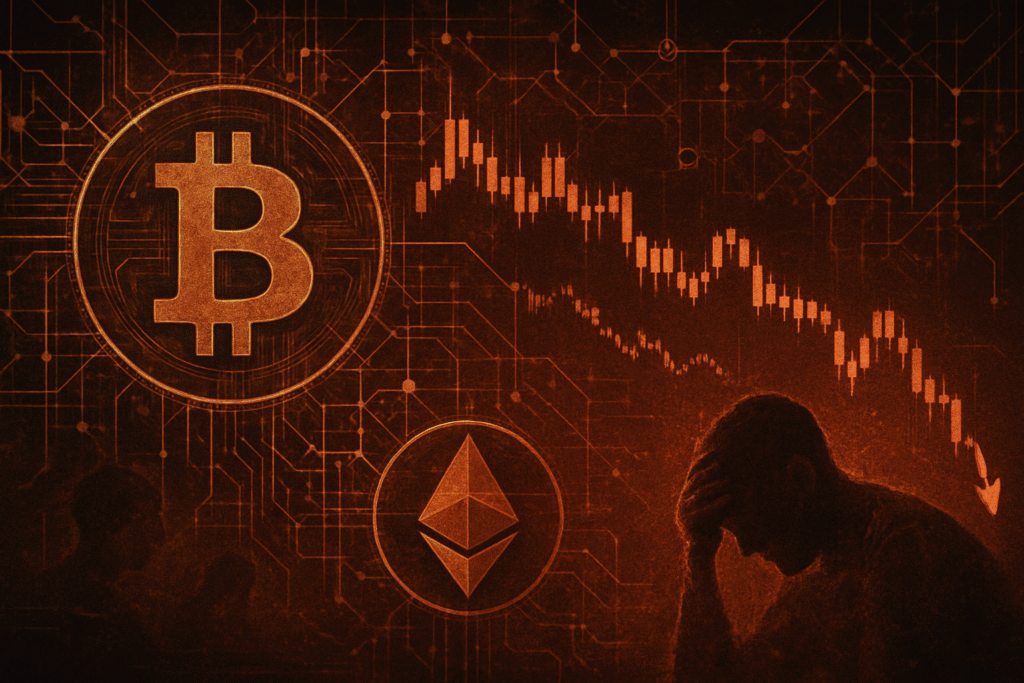
Kyiv, Ukraine – October 13, 2025 – The cryptocurrency world is reeling from a severe market crash and the shocking death of a prominent Ukrainian crypto influencer, Konstantin Galish, also known as "Kostya Kudo." Galish, a 32-year-old entrepreneur and co-founder of Cryptology Key Trading Academy, was found dead in his Lamborghini in Kyiv on October 11, 2025, just as the crypto market experienced one of its most brutal downturns in history. While initial police reports suggest a self-inflicted gunshot wound, with the weapon registered in his name, investigators have not definitively ruled out foul play, fueling intense speculation within the global crypto community.
Galish's death comes at a moment of extreme market turmoil, with the cryptocurrency ecosystem losing nearly $400 billion in market capitalization within 24 hours around October 10-11. This tragic event has cast a stark spotlight on the immense human cost of crypto volatility and the dark underbelly of the high-stakes digital asset world, prompting urgent discussions about mental health, financial pressures, and the potential for nefarious activities in the space. The immediate community response has been a mix of grief, shock, and a renewed focus on the precarious nature of life within the crypto fast lane.
Market Impact and Price Action
The days leading up to and immediately following Galish's death were marked by an unprecedented market collapse, dubbed by some as the "largest liquidation event in history." On October 10-11, 2025, the cryptocurrency market witnessed a catastrophic sell-off, wiping out an estimated $400 billion from its total capitalization. Bitcoin (BTC) plummeted by 9.5%, falling from its previous levels to approximately $111,000, while altcoins, notoriously more volatile, experienced even steeper declines, dropping nearly 20% across the board.
This severe downturn was primarily triggered by a confluence of macroeconomic and geopolitical factors. U.S. President Donald Trump's announcement of 100% tariffs on Chinese imports and tighter software export rules sent shockwaves through global financial markets, causing a widespread sell-off in risk assets. Compounding the panic, the depegging of Binance's (BNB) synthetic stablecoin, USDe, further exacerbated fears and contributed to cascading liquidations. Over $19 billion in leveraged positions were liquidated, trapping countless traders and investors in a rapid downward spiral.
Konstantin Galish himself was reportedly a casualty of this market bloodbath, having lost an estimated $30 million of investor funds in the crash. His personal financial devastation mirrors the broader suffering experienced by many, highlighting how swiftly fortunes can turn in the highly leveraged and unpredictable crypto environment. The market's swift and brutal correction served as a stark reminder of the inherent risks, particularly for those operating with significant leverage or managing substantial investor capital.
Community and Ecosystem Response
The news of Konstantin Galish's death sent shockwaves through the crypto community, triggering a torrent of discussion across social media platforms like X (formerly Twitter) and Reddit. While initial reports pointed to suicide, his prior expressions of depression and financial difficulties, coupled with the sheer scale of his reported losses, have fueled intense debate. Many in the community, aware of the high-pressure environment of crypto trading and the history of suspicious incidents involving crypto figures, are openly questioning whether foul play could be involved, urging thorough investigation.
Beyond the immediate tragedy, Galish's death has amplified ongoing conversations about mental health within the crypto space. The 24/7 nature of the market, coupled with extreme volatility and the potential for life-altering gains or losses, has long been linked to heightened stress, anxiety, and even addiction-like behaviors among traders. Calls for greater awareness and support for mental well-being in the industry have resurfaced with renewed urgency.
The broader crypto ecosystem reacted to the market crash with a mix of panic selling, strategic "buy the dip" maneuvers, and renewed calls for regulatory clarity. Sentiment analysis revealed a significant dip in investor confidence, with many expressing frustration over the lack of safeguards and the centralized points of failure that can exacerbate downturns. While some veteran traders viewed the liquidation event as a necessary "market cleansing" to purge excessive leverage, others highlighted the devastating impact on individual investors and the need for more robust risk management protocols within DeFi protocols and Web3 applications. The incident has also reignited concerns about the "dark side" of crypto, with increasing reports of violence, kidnappings, and suspicious deaths targeting high-profile individuals in the industry, drawing parallels to past incidents like the mysterious death of MakerDAO contributor Nikolai Mushegian in 2022 and the dismembered body of Argentine crypto millionaire Fernando Pérez Algaba in 2023.
What's Next for Crypto
The immediate aftermath of the October 2025 crash and Konstantin Galish's tragic death will likely see continued market volatility and a period of heightened caution among investors. Short-term implications include further deleveraging across the market, as traders and institutions adjust their risk exposure. Projects heavily reliant on speculative trading or with weak fundamentals may face severe challenges, potentially leading to further consolidation within the industry. Regulatory bodies, already scrutinizing the crypto space, are likely to intensify their efforts, pushing for stricter oversight, particularly concerning stablecoins and leveraged trading products.
In the long term, this event could serve as a critical turning point for the crypto market. While painful, such significant corrections often precede periods of more sustainable growth, as weaker projects are purged and the market matures. Potential catalysts for recovery could include clearer regulatory frameworks providing institutional certainty, a de-escalation of global geopolitical tensions, and continued innovation in blockchain technology that demonstrates real-world utility beyond speculation. Strategic considerations for projects and investors will revolve around prioritizing robust risk management, building resilient decentralized infrastructure, and focusing on long-term value creation rather than short-term gains.
Possible scenarios include a prolonged "crypto winter" if macroeconomic conditions worsen or regulatory crackdowns are too severe, or a gradual recovery driven by institutional adoption and technological advancements. The likelihood of a more regulated, albeit potentially less wild, crypto market seems to be increasing, as stakeholders seek to prevent future catastrophes and rebuild trust.
Bottom Line
Konstantin Galish's death amidst one of crypto's most brutal market crashes serves as a somber reminder of the profound human element intertwined with the volatile world of digital assets. For crypto investors and enthusiasts, the key takeaways are clear: extreme market risk is ever-present, mental health is paramount, and the allure of quick riches can come with devastating consequences. It underscores the critical importance of responsible investing, avoiding excessive leverage, and prioritizing personal well-being over speculative gains.
The long-term significance of this event lies in its potential to accelerate the industry's maturation. It forces a critical assessment of current practices, pushing for greater transparency, stronger investor protections, and a more robust regulatory environment. While the promise of crypto innovation remains compelling, the "dark side" — including financial exploitation, potential foul play, and the severe psychological toll of market swings — can no longer be ignored.
Moving forward, important dates, events, or metrics to monitor include upcoming regulatory announcements from major global economies, particularly regarding stablecoins and derivatives. Investor sentiment indicators, trading volumes, and the stability of key macroeconomic factors will also be crucial in gauging the market's trajectory. This incident serves as a stark call to action for the entire crypto community to foster a more secure, responsible, and human-centric ecosystem.
This article is for informational purposes only and does not constitute financial or investment advice. Cryptocurrency investments carry significant risk.





